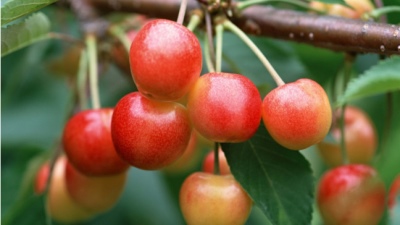
- Pruning: annual, in early spring before bud swelling
- Fruit shape: blunt-hearted
- Keeping quality: not very good (about 2 weeks)
- Authors: Belarusian selection
- Growth type: medium-sized
- Appointment: universal
- Yield: high
- Tree height, m: 3
- Crown: reverse pyramidal, raised, medium density
- Sheet: dark green
Thanks to breeding achievements, cherries can be grown even in regions with unfavorable climates - the main thing is to choose the right variety. Cherry Northern Belarusian selection is ideal for planting in different climatic zones.
Breeding history
Cherry Severnaya is a popular Belarusian variety that appeared in the RUE "Institute of Fruit Growing" of the Republic of Belarus in 1998. The author of the variety is the famous breeder E.P. Syubarova. Recommended for growing sweet cherries in the middle zone of the Russian Federation, as well as in other climatic zones, including the northern regions.
Description of the variety
Belarusian sweet cherry is a medium-sized tree with a raised reverse pyramidal crown, which is moderately thickened with dark green foliage. The tree has good branching; it is especially abundantly overgrown with young twigs located on semi-skeletal branches or on the central conductor. The average height of a tree is 3-3.5 meters.
The tree blooms in medium terms - the second half of May. At this time, the compact and neat crown is covered with medium-sized snow-white flowers, which attract with a persistent and sweet aroma.
Fruit characteristics
North is a small-fruited cherry, the berries of which gain weight up to 4 grams. The shape of the berries is unusual - blunt-hearted with a smooth, shiny cover. At the stage of absolute ripeness, the cherry takes on a beautiful color - a light yellow base, diluted with a pink blush covering half of the fruit. The skin of a sweet cherry is of medium density, with pronounced numerous subcutaneous dots of a light shade. The abdominal suture is small, so it is almost invisible.
The separation from the stalk of the berries is semi-dry, so the keeping quality is average - up to 2 weeks, if the drupe has a tail. The transportation of the berries is well tolerated, but not over long distances.
The use of sweet cherries is wide - cooking (filling for pies), processing into preserves and jams, canning whole, freezing, eating fresh.
Taste qualities
Cherry of Belarusian selection has an excellent taste. The pale pink flesh has a fleshy, medium-dense, juicy consistency. The fruit has a harmonious taste - sweet and sour, perfectly complemented by a dessert aroma. Rich and aromatic light pink juice. The skin is soft, without bitterness. The stone is easily separated from the fetus. Cherry pulp contains more than 12% sugars and less than 1% acids.
Ripening and fruiting
The variety belongs to the mid-season class. The first harvest can be observed in the 4th year after planting. The berries are spiced together. Fruiting is stable - annual. The active ripening period begins in mid-July. It is not recommended to overexpose ripe berries on the tree, as they attract birds very much.

Yield
High yield is one of the advantages of this variety. During the season, an average of 70 kg of cherries can be harvested from one adult tree. The maximum yield was recorded at around 28 tons per hectare.
Growing regions
The cultivation geography of the variety has expanded significantly over the past decade. Cherry Severnaya is planted in the Moscow and Bryansk regions, as well as in most of the country. In addition, the tree is popular in the southern strip of Belarus, in the mountainous and northern regions of Scandinavia.
Self-fertility and the need for pollinators
Sweet cherry is self-fertile, therefore it is recommended to immediately plant pollinating varieties. The following varieties of sweet cherries are considered productive: Syubarovskaya, Narodnaya, Krasavitsa, Muscat, Pobeda and Zolotaya Loshitskaya.
Growing and caring
Planting seedlings is best done in early spring - before the start of the growing season. The optimal planting material will be an annual seedling with a developed rhizome and a tree height of up to 100 cm. Planting is carried out according to a 5x3 meter scheme. The site should not be in the lowlands, clean from weeds, well lit by the sun and protected from the north wind.
Intensive agricultural technology consists of standard procedures - regular watering, fertilizing three times per season, sanitary pruning of branches in spring (April), crown molding, plowing and weeding of the soil, disease prevention, mulching and preparation for winter. An important measure is protection from birds - hanging CDs or covering with a fine-mesh soft net.




Disease and pest resistance
The North cherry has a high immunity. The tree perfectly resists fungi and mold. It does not undergo coccomycosis and moniliosis.

Requirements for soil and climatic conditions
Cherries of the Belarusian selection are thermophilic, they love the air and the sun. It is also worth noting high frost resistance (temperature drop to –30 ... 34 degrees) and shade tolerance. A tree can endure drought for a short time.
It is comfortable to grow cherries in loose, fertile, moist and breathable soil with a neutral acidity. The passage of groundwater must be deep.
































































